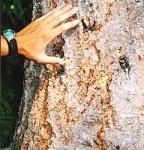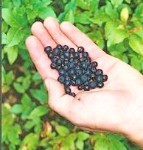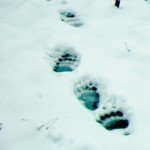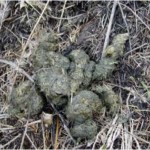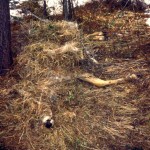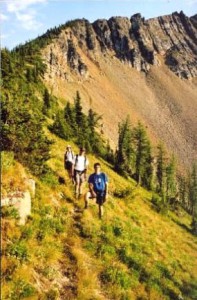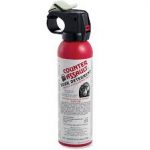REVISE TO TALK ABOUT BOTH BEARS – CURRENT INFORMATION
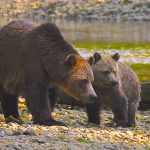
If you spend time in the North Cascades and other rural areas of Washington, the chances of seeing a black bear are quite high. You are much less likely to see a grizzly bear. Watching bears in their natural environment from a safe, respectable distance can be thrilling – they are far more likely to enhance your wilderness experience than spoil it. Knowing how to interpret their behavior and act responsibly is part of the thrill of sharing forests and mountains with wildlife.
The vast majority of bears want to avoid humans. Encounters with aggressive bears are very rare.
Below are simple steps you can take while living, camping, backpacking, and horseback riding in bear country. You can also watch our
Bear Safety Public Service Announcement: with WWO founder, Chris Morgan.
Bear Spray
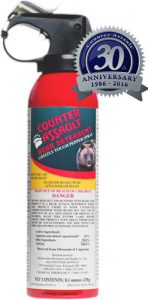
The active ingredients in bear spray are capsaicin and related capsaicinoids. There is a significant difference between the amount of capsaicin in bear spray sold for protection from bears, and in the pepper spray sold for protection from human aggressors. Be sure to buy bear spray, not pepper spray, buy a canister that has a spray duration of at least 6 seconds, and follow the directions for use. Consider buying a bear spray holster so the spray is always easily accessible, and consider carrying spray in hand while walking through heavy brush or other areas with poor visibility.
Bear spray is a good last line of defense, but it is not a substitute for vigilance and following appropriate bear avoidance safety techniques. Bear spray is intended to create a wide barrier between you and the bear, so the spray can affect the bear’s eyes, nose, throat, and lungs. Spray when a bear is no less than 25 feet away. Point the canister slightly downwards and spray in 2 to 3 second bursts in the direction of the bear with a slight side-to-side motion. This distributes an expanding cloud of spray that the bear must pass through before it gets close to you. Spray additional bursts if the bear continues toward you. Continue spraying until the bear either breaks off its charge or is going to make contact. Bear spray has been shown to reduce the length and severity of serious physical attacks when used properly. Bear spray should not be used as a preventative measure: never spray your backpack, tent or person with bear spray.
At your home or ranch
Bears emerging from and returning to their dens have 5 to 7 months to gain enough weight to sustain them through their winter denning. Easily obtainable, high-calories meals like food items in garbage cans, bird feeders, pet food and compost often attract bears and bring them in close proximity to humans. Whether it is a bear’s first visit or a repeat visit to someone’s yard, their presence may lead to conflict. Bears that are fed intentionally or unintentionally by people often lose their fear of humans, may become aggressive, and may cause property damage. Once a bear becomes food-conditioned and habituated, wildlife agencies may be forced to kill it. It is important to remember that ‘a Fed Bear is a Dead Bear’.
- Store garbage indoors or in bear-resistant garbage cans.
- Do not leave food, scraps, garbage, recycling or pet food accessible to bears.
- Haul garbage to a dump site at least twice a week to avoid odors.
- If you have a pickup service, put garbage out the morning of pick up– not the night before.
- If you’re leaving home several days before pickup, haul your garbage to a dump.
- Be particularly aware of very odorous food scraps such as fish and meat bones/scraps – store them in the freezer until garbage day.
Barbecuing
- Be alert when barbecuing. If bears are nearby, they may be attracted by the smell.
- Keep barbecue grills clean and free from grease. Store inside if possible.
Pets
- It is better to keep pets inside at night if possible.
- Do not leave pet food, livestock food, or poultry feed outside without electric fencing.
More Helpful Tips
- Composts, fruit trees and beehives are powerful bear attractants, as are vegetable and flower gardens – enclose them with electric fencing.
- Do not put fish, meat or fruit into your compost. Use lime to reduce odors.
- Make sure that bird feeders, bird seed, suet and hummingbird mixes are not accessible to bear.
- Try to pick fruit from trees on your property regularly. Rotting fruit left on the ground is a powerful bear attractant.
- Avoid the use of outdoor refrigerators and freezers– they will attract bears.
In your community
- Promote the use of community bear resistant dumpsters.
- Support local businesses and families that take “bear smart” sanitation steps.
- Encourage the use of bear alert programs to share information on bear activity among community members.
- Strongly discourage the feeding of bears by tourists or other residents.
- Reduce the availability of natural bear food sources in and around parks, schools, and green spaces.
- Encourage bear safe design and management of trails, campgrounds, and parks.
Manufacturers of bear resistant garbage cans:
At your campsite
The following tips are equally important whether camping off-trail, or in multi-site campgrounds close to the road: both should be considered part of bear country and should be afforded the same safety precautions. Bear in mind that neighboring campers and campers that have left prior to your arrival may not be taking the same precautions, so be especially vigilant when utilizing campgrounds.
Camp setup
- If camping in National Parks, camp in established campsites and follow park guidelines.
- Be aware of your surroundings – look at them from a bear’s perspective. Investigate your site for bear sign before setting up camp and then establish a clean camp free of odors
- Avoid camping near bear food sources such as berries. Never camp near an animal carcass, garbage or bear sign such as tracks, scat or tree scratchings.
- Avoid camping next to trails or streams, as bears and other wildlife use these as travel routes.
- Remember the 100 yard rule: locate your cook area and food cache at least 100 yards downwind from your tent when not in established campgrounds.
- Pitch tents in a line or a semicircle facing your cooking areas. You will be more likely to spot a bear that wanders into your camp and the bear will have a clear escape route. Below is an illustration of a bear-safe campsite:
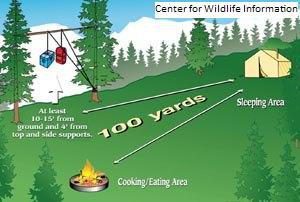
Food storage
- Do not forget: when hanging your food and garbage you’ll need 100 feet of strong nylon accessory cord (1/8 inch minimum) and a carabiner to attach bags to cord.
- Never leave food items unattended unless it is properly stored. Food items include all edibles (even in sealed packaging), drinks, coolers (even when empty), and pet food (even fishing bait).
- DO NOT bring food, drinks, or odorous non-food items into your tent. This includes toothpaste, perfume, deodorant, chocolate, candy and wrappers.
- Avoid canned foods with strong odors such as tuna. Wash cans after eating.
- All food items should be placed in bear-resistant food storage containers (where available) or stored in your vehicle’s trunk or your truck cab. Bear-resistant containers are constructed of a securable, solid non-pliable material capable of withstanding force from a bear. Visit www.igbconline.org to learn about certified bear-resistant containers.
- When you are not able to keep food stored in bear-resistant containers, hang your food. Place food inside several layers of sealed plastic bags and a stuff-sac (‘bear bags’ or waterproof ‘dry-bags’ can be purchased for this use) and hang the bags at least 15 off the ground between two trees that are 20 feet apart. Some campgrounds provide communal bear wires for this purpose.
- If two trees are not available, sling your bags at least 15 feet from the ground over the branch of one tree so that the bags hang at least 5 feet out from the tree trunk and hang 5 feet below the branch.
- Remember to hang pots, utensils, cosmetics, toiletries and any other odorous items with your food and garbage.
- Bear-resistant food containers (BRFCs) can be borrowed from some National Park and Forest Service offices.
Cooking
- NEVER cook or eat in your tent – the tent will smell of food and may attract bears. Avoid cooking greasy, odorous foods.
- Locate your cook area and hang your food at least 100 yards downwind from your tent.
- Remove the clothing you wore while cooking before going to sleep. Store these clothes in your vehicle or with your food and garbage.
- Wash all dishes immediately after eating. Dump water at least 100 yards from your campsite.
Garbage disposal/storage
- Never leave garbage unattended, unless it is properly stored.
- Do not bury your garbage. Garbage should be deposited in bear-resistant garbage cans or stored in your vehicle until it can be dumped.
- If you are unable to store garbage in a bear-resistant container, hang garbage in the same way as your food.
- Remember: “pack it in, pack it out”. This includes ALL garbage (including biodegradable items such as fruit peels).
Hiking and horse packing
If you spend much time in the rural areas of the western United States, the chances of seeing a black bear are quite reasonable. You are less likely to see a grizzly bear; there are relatively few in the Lower 48 States, found only in northern Washington and Idaho, northwest Montana, and around Yellowstone National Park. Watching bears in their natural environment from a safe, respectable distance can be enjoyable. Positive experiences with wild bears are far more common than negative experiences. Although extremely rare, aggressive encounters between people and bears sometimes occur. Call for any recent reports of bear activity in the area you plan to hike. Bears feel threatened if surprised. If a bear hears you coming, it will usually avoid you. To avoid bears:
- Talk or sing songs as you walk – especially in dense brush where visibility is limited, near running water or when the wind is in your face. Your voice will help bears to identify you as human.
- Hike in a group and during daylight hours.
- Be aware. Learn about and watch for bear sign. Overturned rocks or broken-up, rotten logs can be a sign that a bear has been foraging for grubs or insects. Claw marks on trees, five-toed tracks in the dirt or snow, berries on the ground, plant root diggings or fur on the bark of trees are all signs that a bear has been in the area. If you see fresh bear sign, leave the area immediately.
- Stay away from abundant food sources and dead animals – bears may be foraging in the area or protecting a carcass.
- Keep dogs on a leash and under control. Dogs may be helpful in detecting bears, but they may also fight with them or lead them back to you.
- Avoid wearing scented cosmetics and hair products
- Carry bear spray, have it ready and know how to use it! For more information, click on the image below.
Hunting and fishing
The very act of hunting puts hunters at an increased risk of encountering grizzlies; elk bugling, game calls, and cover scents attract not only game, but bears too.
- It is illegal to hunt grizzly bears in the lower 48 states, as they are listed under the Endangered Species Act. Learn how to identify the difference between grizzly and black bears. Be absolutely sure of your target. If in doubt, do not shoot.
- When hunting in grizzly country, carry bear spray. Keep the spray within reach, and be familiar with the firing mechanism.
- Leave detailed plans with someone, and check-in periodically.
- Field dress and remove your kill from the field immediately. The longer a carcass remains lying on the ground, hung near hunting camp, or in the back of a truck, the more likely it is to attract a bear.
- If you must leave a carcass in the field, hang it so the lowest part of the carcass is at least 10 feet off the ground and 300 feet away from recreation/camping/sleeping sites.
- If a grizzly bear is at the kill site, do not attempt to frighten away or haze a grizzly that does not leave a carcass!
- If you see no sign of a bear when returning to the site, approach the carcass slowly. Yell repeatedly, and make noise to frighten away any bear you didn’t see!
- Learn how to tell black bears and grizzly bears apart, click here to go to Bear Identification section.
- To take a bear ID test, visit this site (not associated with WWO).
Visit the Products page to see our Bear Safety brochure and the Grizzly Bears of the North Cascades Brochure
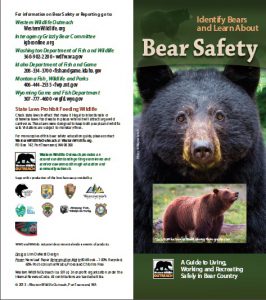
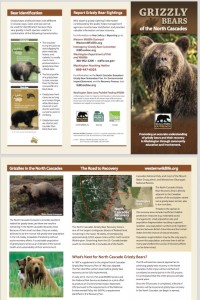
Bear signs to watch for: Signs of bear claw marks on trees and logs, ripened berries, paw prints, bear scat (dung) and partially buried carcasses.
